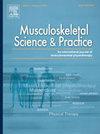Cultural adaptation and psychometric validation of the exercise adherence Rating scale Mexican Spanish version (EARS-Mx)
IF 2.2
3区 医学
Q1 REHABILITATION
引用次数: 0
Abstract
Objective
The aim has been to translate and cross-culturally adapt the Exercise Adherence Rating Scale (EARS) for Mexican Spanish speaking population with non-specific chronic low back pain and assess its psychometric properties.
Methods
The study had two phases: translation and cultural adaptation, followed by psychometric validation. Reliability was assessed with internal consistency (Cronbach's alpha) and test-retest reliability (intraclass correlation coefficient); validity with construct validity (Spearman's correlation) and factor analysis; sensitivity to change with effect size and standardized response mean difference; feasibility by completion time in seconds; and ceiling/floor effects were calculated.
Results
A total of 161 subjects were included. Cronbach's alpha (0.93; 95% CI 0.92–0.95) indicated good internal consistency, and intraclass correlation (0.95; 95% CI: 0.89–0.97) showed excellent test-retest reliability. Weak correlations between the EARS vs. the Visual Analogue Pain Rating Scale and the Roland Morris Disability Questionnaire were found (r = −0.29 and r = 0.00 respectively). All effect size values indicated that the scale presented a significant sensitivity to change. The average time to complete the EARS-Mx was 219 s. No ceiling or floor effect was detected.
Conclusion
The EARS-Mx showed semantic, conceptual, idiomatic, content and operational equivalence with respect to the original scale, and appropriate metric properties of reliability, validity, sensitivity to change and feasibility.
墨西哥西班牙语版运动依从性评定量表(ear - mx)的文化适应与心理测量学验证
目的:翻译和跨文化适应墨西哥西班牙语人群非特异性慢性腰痛的运动依从性评定量表(EARS),并评估其心理测量特性。方法研究分为翻译和文化适应两个阶段,然后进行心理测量验证。信度评估采用内部一致性(Cronbach’s alpha)和重测信度(类内相关系数);效度与构念效度(Spearman’s相关)及因子分析;敏感性随效应大小和标准化反应平均差的变化;以秒为单位的可行性完成时间;并计算天花板/地板效应。结果共纳入161名受试者。Cronbach’s alpha (0.93;95% CI 0.92-0.95)表明具有良好的内部一致性,类内相关性(0.95;95% CI: 0.89-0.97)显示极好的重测信度。ear与视觉模拟疼痛评定量表和Roland Morris残疾问卷之间存在弱相关性(r = - 0.29和r = 0.00)。所有效应值均表明量表对变化具有显著的敏感性。完成ars - mx的平均时间为219 s。没有检测到天花板或地板效应。结论ear - mx量表在语义、概念、习语、内容和操作等方面与原量表相当,在信度、效度、变化敏感性和可行性等方面具有适当的度量特性。
本文章由计算机程序翻译,如有差异,请以英文原文为准。
求助全文
约1分钟内获得全文
求助全文
来源期刊

Musculoskeletal Science and Practice
Health Professions-Physical Therapy, Sports Therapy and Rehabilitation
CiteScore
4.10
自引率
8.70%
发文量
152
审稿时长
48 days
期刊介绍:
Musculoskeletal Science & Practice, international journal of musculoskeletal physiotherapy, is a peer-reviewed international journal (previously Manual Therapy), publishing high quality original research, review and Masterclass articles that contribute to improving the clinical understanding of appropriate care processes for musculoskeletal disorders. The journal publishes articles that influence or add to the body of evidence on diagnostic and therapeutic processes, patient centered care, guidelines for musculoskeletal therapeutics and theoretical models that support developments in assessment, diagnosis, clinical reasoning and interventions.
 求助内容:
求助内容: 应助结果提醒方式:
应助结果提醒方式:


